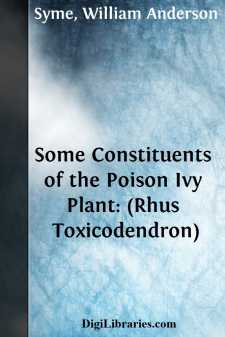Categories
- Antiques & Collectibles 13
- Architecture 36
- Art 48
- Bibles 22
- Biography & Autobiography 813
- Body, Mind & Spirit 142
- Business & Economics 28
- Children's Books 16
- Children's Fiction 13
- Computers 4
- Cooking 94
- Crafts & Hobbies 4
- Drama 346
- Education 46
- Family & Relationships 57
- Fiction 11829
- Games 19
- Gardening 17
- Health & Fitness 34
- History 1377
- House & Home 1
- Humor 147
- Juvenile Fiction 1873
- Juvenile Nonfiction 202
- Language Arts & Disciplines 88
- Law 16
- Literary Collections 686
- Literary Criticism 179
- Mathematics 13
- Medical 41
- Music 40
- Nature 179
- Non-Classifiable 1768
- Performing Arts 7
- Periodicals 1453
- Philosophy 64
- Photography 2
- Poetry 896
- Political Science 203
- Psychology 42
- Reference 154
- Religion 513
- Science 126
- Self-Help 84
- Social Science 81
- Sports & Recreation 34
- Study Aids 3
- Technology & Engineering 59
- Transportation 23
- Travel 463
- True Crime 29
Some Constituents of the Poison Ivy Plant: (Rhus Toxicodendron)
Description:
Excerpt
INTRODUCTION.
Plants belonging to the natural order Anacardiaci? (Cashew family or Sumach family) are found in all the temperate climates of the world and quite frequently in semi-tropical climates. Many of these plants play important parts in economic botany, yielding dye-stuffs, tanning material, wax, varnish, and drugs. Several species are poisonous. At least three poisonous species of the genus Rhus are found in the United States. These three are all common and well-known plants, but confusion frequently arises concerning them on account of the different names by which they are known in different localities. For example, poison ivy (Rhus toxicodendron or Rhus radicans) probably the best known poisonous plant in America, being found in all the States except those in the extreme West, is often confounded with and popularly called "poison oak." The true poison oak is the Rhus diversiloba of the Western States. The third and most poisonous species of this plant is Rhus venenata or Rhus vernix; it is the Rhus vernicifera of Japan, from which Japanese lac is obtained. It is popularly known in the United States as "poison sumach," "poison dogwood" and "poison elder." It grows in swamps from Canada to Florida.
As the poison ivy is by far the most common of these plants in the Eastern States, a brief description of it is given here: A shrub climbing by rootlets over rocks, etc., or ascending trees, or sometimes low and erect; leaflets 3, rhombic-ovate, mostly pointed, and rather downy beneath, variously notched, sinuate, or cut-lobed; high climbing plants (R. radicans) having usually more entire leaves. It is found in thickets, low grounds, etc. Greenish flowers appear in June.
Fig. 1.âPoison ivy (Rhus radicans or Rhus toxicodendron). a, spray showing aerial rootlets and leaves; b, fruitâboth one-fourth natural size.(Chesnut, Bulletin No. 20, Division of Botany, U. S. Department of Agriculture.)Fig. 2.âPoison oak (Rhus diversiloba) showing leaves, flowers, and fruit, one-third natural size. (Chesnut, Bulletin No. 20, Division of Botany, U. S. Department of Agriculture.)Fig. 2.âPoison oak (Rhus diversiloba) showing leaves, flowers, and fruit, one-third natural size.
(Chesnut, Bulletin No. 20, Division of Botany, U. S. Department of Agriculture.)
In the general description of the order Anacardiaci?, Gray says: "Juice or exhalations often poisonous." Whether it is contact with some part of the plant, or with the exhalation from the plant, that causes the well-known skin eruption has been a topic for discussion ever since its source was known. On account of its intangible nature there has been more speculation than experimental evidence bearing on this question, although a few investigations have been made with the object of isolating the poison. It is most generally believed that the exhalations are poisonous. Dr. J. H. Hunt states that the exhalations have been collected in a jar and found to be capable of inflaming and blistering the skin of an arm plunged into it.
...

